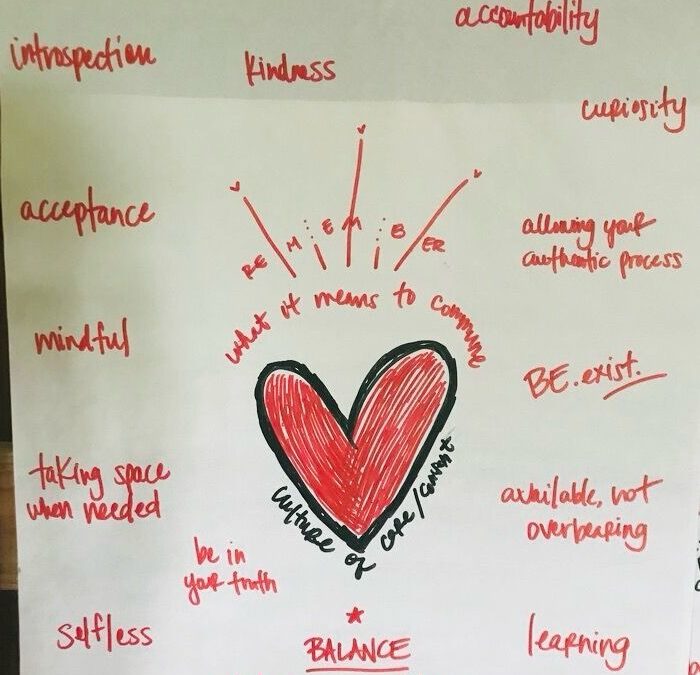
by Cortina Jenelle | Sep 12, 2023 | blog, creative coach, deib, entrepreneur coach, facilitation, sacred heart
Culture of care is often something I talk about in my work with young professionals, students, community partners and clients. It seems like more and more, these concepts need to be brought to the forefront in team spaces because it’s not standard for us these days. But, is there a such thing as too much compassion or empathy? In my DEIB work especially, people are concerned with where to draw the line about triggers and how to respond to conflict. It’s not always easy to track the ROI of human relations where we work and learn. But the lack of care in any space certainly be felt.
I have a proposition for you.
What if you proactively, or as soon as you can, establish some parameters and agreements for creating and sustaining a culture of care at your job, project or school? Meaning, the work and the mission is important but not at the expense of leaving people behind or sacrificing their well-being to get there.
Not having a true culture of care costs us good people, takes more time (spent on putting out little fires, addressing conflict or violations) and less time is spent on the actual work anyways so why not create a clear container so that people feel seen, heard, valued and respected. This leads to a clear path to express our boundaries, needs and discomforts *without* making someone also the scapegoat to fix it.
Is this something you could imagine using, or have used in your work or learning spaces?
Food for thought!

by Cortina Jenelle | Apr 20, 2023 | blog, business, deib, facilitation, imagination
Over the years, I have had conversations with many business and nonprofit leaders as they are in the trenches and seeking to engage the Black, indigenous, persons of color (BIPOC) population as their grants compel them to do. Gaps in engagement and participation in programming by the BIPOC community point to a lack of trust, or more importantly, a lack of relationship with the BIPOC community that the grants are written on behalf of. Engaging authentically is paramount if nonprofit leaders want to engage in a space of empathy and mutual aid as opposed to sympathy and charity.
NURTURE A CONNECTION THROUGH APPRECIATION
For nonprofit leaders aiming to foster a deeper connection with the Black community, a thoughtful and multifaceted approach is necessary. Firstly, it is pivotal to comprehend the historical and cultural context surrounding the Black community. This entails educating oneself about the historical experiences and significant contributions of the Black community both regionally and globally. It is equally important to recognize the nuances and the rich diversity within the Black community, understanding that it is not a monolithic group. Cultivating a deep appreciation for the vibrant cultural heritage while avoiding stereotyping and assumptions is an essential part of this process.
SPARK CONVERSATIONS
Next, embarking on the path of meaningful dialogue is key. This can be facilitated through community meetings where individuals can express their viewpoints and concerns, thereby fostering open conversations. Additionally, establishing channels for community members to offer feedback and suggestions on initiatives will further enhance collaboration. Collaborative efforts, including forming partnerships with existing organizations within the Black community and involving community representatives in planning and decision-making processes, can help in aligning the initiatives more closely with the community’s needs and aspirations.
CELEBRATE CULTURES
Showcase and celebrate the rich diversity within the Black community. Organize cultural events and promote the arts and heritage through various platforms to celebrate diversity. Collaborative celebrations, such as working with community groups to organize events and showcasing stories of individuals making positive impacts, can serve to amplify the sense of community and celebration.
IMPLEMENT + ITERATE
As nonprofit leaders navigate this journey, continuous learning and adaptation should be at the forefront. Reflect regularly on the outcomes of your initiatives, learning and adapting from experiences. Establish a feedback loop with the community to continually refine and enhance your approaches. Be prepared to adapt strategies based on insights gained from engagements and stay responsive to the evolving dynamics and needs within the community.
Photo by Lucie Hošová on Unsplash

by Cortina Jenelle | Feb 19, 2023 | blog, business, deib, facilitation
In contemporary work environments, cultivating a culture steeped in diversity, equity, inclusion, and belonging (DEIB) principles is not only beneficial but essential. Nonprofit professionals all over the country are evaluating how, or if, their current workplace environment embraces DEIB. Although there is no cookie-cutter method for how to implement DEIB, a workplace that actively promotes employee well-being, happiness, and advancement are great signs of a healthy environment.
Let’s take it a step at a time.
First, it is vital to understand and internalize DEIB principles fully. This process begins with fostering education and awareness through regular workshops and training programs aimed at enhancing employees’ understanding of DEIB. Collaborating with experts to deepen the grasp of DEIB principles can provide a rich, well-rounded perspective. Furthermore, encouraging introspection within the workplace is key. Employees should be urged to examine their own biases and perspectives critically. Facilitating open dialogues where individuals can share experiences and insights can be a transformative exercise, fostering understanding and empathy.
The second step involves the meticulous implementation of DEIB-focused policies. During the recruitment phase, efforts should be directed towards attracting a diverse talent pool that reflects various backgrounds and experiences. Instituting a bias-free selection process can be instrumental in achieving this. Additionally, emphasis should be placed on employee development, promoting career progression for all, especially those from underrepresented groups. Introducing mentorship programs can play a pivotal role in nurturing diverse talents and fostering a sense of community and support.
Moving forward, fostering an inclusive environment is of paramount importance. This includes nurturing a workplace culture that encourages the use of inclusive language and the creation of safe spaces where employees can express themselves without fear of judgment. Flexible work policies can also be a vital aspect of this inclusive environment. Offering options like remote work and advocating for a healthy work-life balance can cater to the diverse needs of the workforce, promoting overall well-being.
After that foundation is laid, adopting a stance of continuous evaluation and improvement can further enhance the effectiveness of DEIB initiatives. This involves establishing channels for employees to provide feedback on existing initiatives and conducting regular surveys to gauge the experiences and perspectives of employees. Utilizing data-driven approaches, like data analysis, can aid in measuring the success of DEIB initiatives, allowing for necessary adjustments based on insights gleaned from the data.
Finally, a concerted effort must be made to promote a sense of belonging and well-being within the organization. Community-building initiatives such as team-building activities can foster a strong sense of community and belonging. Establishing support networks where employees can find assistance and guidance can be a comforting addition. Moreover, introducing well-being initiatives like mental health support and wellness programs can significantly contribute to the physical and mental well-being of employees.
By thoroughly integrating DEIB principles into every facet of an organization, it is possible to create a workplace that is not only inclusive and equitable but also fulfilling, supportive and productive. This gets us one step closer to an environment fosters a high level of well-being, happiness, and advancement for all employees, setting the stage for a harmonious and progressive organizational culture.
Photo by Miles Peacock on Unsplash



